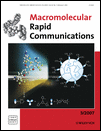Formation of Honeycomb Structures and Superhydrophobic Surfaces by Casting a Block Copolymer from Selective Solvent Mixtures
Abstract
Poly(vinyl phenol)-block-polystyrene (PVPh-b-PS) diblock copolymers are synthesized by sequential anionic polymerization with sec-butyl lithium as the initiator. The PVPh-b-PS diblock copolymer is cast (on a substrate) from several solvent mixtures that contain tetrahydrofuran/toluene ratios of 1:0.1, 1:1, and 1:2. After solvent evaporation the resulting films are characterized by SEM, TEM, and contact angle measurements. A honeycomb structure is fabricated from the vesicle structure at relatively low toluene contents. On the contrary, at relatively higher toluene contents, a micelle structure with porous microspheres is formed, which possesses higher surface roughness and results in film surface superhydrophobicity. The simple method described here that uses common/selective mixed solvents may be easily extended to prepare honeycomb structures and superhydrophobic surfaces simultaneously from a wide variety of block copolymers by carefully controlling the weight composition of the block copolymer and the selective solvent content.





